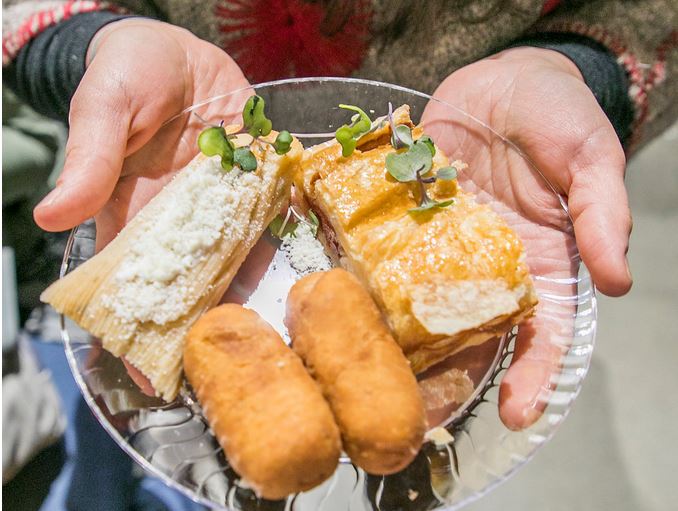The growing popularity of Latin American food in the US is driving increased interest in authentic Latin cuisine and a deeper appreciation for its origins and the people who cook it, panelists said during an event held in Washington, D.C., last month. Titled “Comida Latina,” the panel event hosted by Pineapple Collaborative and moderated by Katalina Mayorga of El Camino Travel brought together a group of entrepreneurs to discuss how the country’s growing appetite for Latin food is affecting their businesses and the overall US food scene.
Helping diners dig deeper to discover authentic cuisine
“When we talk about Latin food, people think about burritos, tacos, enchiladas, and it’s hard for them to go beyond that,” said Joahna Hernandez, founder of Manos de Maiz, which makes and sells tortillas, tamales and other dishes made from heritage corn through D.C. farmers markets and catering. By focusing on authentic ingredients and preparations from her native Mexico, businesses like Hernandez’s are helping educate US diners on the diversity of Latin cuisine and show them “Mexican food is not all [there is to] Latin food, and also there is more to see and explore in Mexican food,” she said.
When Gabriela Febres co-founded the Arepa Zone food truck in 2014, her company was the first to offer Venezuelan-style arepas in D.C. The popular brand has grown to include a stall in the Union Market food hall and a brick-and-mortar location, but education is still part of the day-to-day for Febres and her team.
“It is a challenge because people say, ‘Oh, a taco truck!’ And we’re like ‘kind of — let’s work through it,’” she said.
One of the most common things people misunderstand about the stuffed corncakes and Venezuelan food in general is that it isn’t spicy. “We don’t eat spicy food in Venezuela, it’s not a thing,” Febres said. “And people are surprised by that, but I always embrace each opportunity to talk to people about our food and explain that every country is different and there is so much more to be learned about every country and what they have to offer.”
Strengthening cultural connections through food
The recipes and techniques Febres and her staff use at Arepa Zone are shaped by family traditions, and opening her business helped bring her closer to her heritage and family.
“When we opened Arpea Zone I was talking to my grandmother on Skype every other day, because I’m relearning the recipes from my own culture,” she said.
For Daniella Senior, serving as director of operations for her restaurant Colada Shop is an opportunity to deepen her understanding of a Latin cuisine and culture other than her own. Senior is from the Dominican Republic, but Colada Shop features a menu of classic Cuban food and drinks and an atmosphere designed to emulate the Cuban custom of connecting over a cup of coffee or a meal.
When working with the cuisine of another place, Senior said it’s important to “get to know each country and…the diversity that exists within it.”
Fighting appropriation with advocacy
Food is seen by many as a universal language, and artist Marcella Kriebel admires its ability to act as a gateway into other cultures. In her illustrated cookbooks Comida Latina and Comida Cubana, she shares recipes and stories from her time spent in Latin America. Her fellow panelists praised Kriebel’s work for being thoroughly researched and celebratory of the cultures it represents — an opposing force to the exploitative practices of other white artists, chefs and influencers who appropriate other cultures without accurately representing them.
Febre said what makes Kriebel’s books successful is the fact that she “did her homework.” Senior agreed, and said that there is value in representations of Latin cuisine presented by non-Latinos because they help draw in members of different communities. “Sometimes when you take someone from somewhere else who has done the homework of understanding how to relate it better to their own culture I think they get much further…and they capture a bigger audience,” she said.
It’s important that people who have the ability to capture these large audiences understand the responsibility that comes with being in a position of power, Kriebel said. She suggested that chefs do their part by creating more opportunities for line cooks, many of whom are minorities whose cultures and cuisines are underrepresented in the US.
“If you have the upper hand in some sphere…maybe there is an avenue where you have a special made by that person — just a dish — to highlight someone else who is often in the background,” Kriebel said.
This spirit of advocacy, affirmation and understanding is something that could help broaden more than menus — it could make the food world a more diverse, inclusive place.
________________________________________________
If you enjoyed this article, join SmartBrief’s email list for more stories about the food and beverage industry. We offer 20 newsletters covering the industry from restaurants to food manufacturing. And be sure to follow us on Twitter for the latest industry news.
